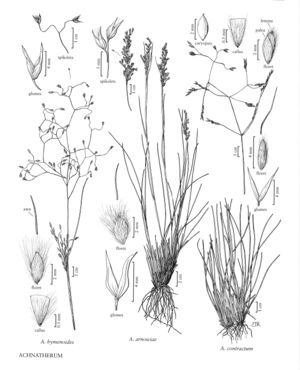Difference between revisions of "Achnatherum contractum"
FNA>Volume Importer |
imported>Volume Importer |
||
| (8 intermediate revisions by 2 users not shown) | |||
| Line 7: | Line 7: | ||
|synonyms={{Treatment/ID/Synonym | |synonyms={{Treatment/ID/Synonym | ||
|name=Oryzopsis contracta | |name=Oryzopsis contracta | ||
| − | |authority= | + | |authority= |
| + | |rank=species | ||
}} | }} | ||
|hierarchy=Poaceae;Poaceae subfam. Pooideae;Poaceae tribe Stipeae;Achnatherum;Achnatherum contractum | |hierarchy=Poaceae;Poaceae subfam. Pooideae;Poaceae tribe Stipeae;Achnatherum;Achnatherum contractum | ||
| Line 20: | Line 21: | ||
-->{{Treatment/Body | -->{{Treatment/Body | ||
|distribution=Mont.;Colo.;Wyo. | |distribution=Mont.;Colo.;Wyo. | ||
| − | |discussion=<p>Achnatherum contractum grows in rocky grasslands in eastern Idaho, southwestern Montana, and Wyoming. It is a fertile derivative of a Piptatherum micranthum x Achnatherum hymenoides hybrid (Shechter and Johnson 1968; Shechter 1969). Immature specimens of A. hymenoides are sometimes confused with A. contractum because they have contracted panicles with appressed branches and pedicels; they differ in having pedicel pairs in which the shorter pedicel is more than half as long as the longer pedicel.</p> | + | |discussion=<p><i>Achnatherum contractum</i> grows in rocky grasslands in eastern Idaho, southwestern Montana, and Wyoming. It is a fertile derivative of a <i>Piptatherum micranthum</i> x <i>Achnatherum hymenoides</i> hybrid (Shechter and Johnson 1968; Shechter 1969). Immature specimens of <i>A. hymenoides</i> are sometimes confused with <i>A. contractum</i> because they have contracted panicles with appressed branches and pedicels; they differ in having pedicel pairs in which the shorter pedicel is more than half as long as the longer pedicel.</p> |
|tables= | |tables= | ||
|references= | |references= | ||
| Line 29: | Line 30: | ||
-->{{#Taxon: | -->{{#Taxon: | ||
name=Achnatherum contractum | name=Achnatherum contractum | ||
| − | |||
|authority=(B.L. Johnson) Barkworth | |authority=(B.L. Johnson) Barkworth | ||
|rank=species | |rank=species | ||
| Line 36: | Line 36: | ||
|basionyms= | |basionyms= | ||
|family=Poaceae | |family=Poaceae | ||
| + | |illustrator=Cindy Roché | ||
| + | |illustration copyright=Utah State University | ||
|distribution=Mont.;Colo.;Wyo. | |distribution=Mont.;Colo.;Wyo. | ||
|reference=None | |reference=None | ||
| Line 41: | Line 43: | ||
|publication year= | |publication year= | ||
|special status= | |special status= | ||
| − | |source xml=https:// | + | |source xml=https://bitbucket.org/aafc-mbb/fna-data-curation/src/200273ad09963decb8fc72550212de541d86569d/coarse_grained_fna_xml/V24/V24_189.xml |
|subfamily=Poaceae subfam. Pooideae | |subfamily=Poaceae subfam. Pooideae | ||
|tribe=Poaceae tribe Stipeae | |tribe=Poaceae tribe Stipeae | ||
Latest revision as of 17:22, 11 May 2021
Plants tightly cespitose, not rhizomatous. Culms 30-50 cm tall, 1-1.3 mm thick, glabrous; nodes 3-4. Sheaths glabrous; collars puberulent, hairs about 0.2 mm, sometimes the margins with poorly developed tufts of hair to 0.5 mm; ligules 1.8-5 mm, broadly to narrowly acute, glabrous; blades 0.5-1.5 mm wide, flat or convolute, abaxial surfaces smooth, adaxial surfaces scabridulous. Panicles 6-25 cm long, 7-15 cm wide; branches ascending to strongly divergent, longest branches 5-8 cm; pedicels appressed to the branches, paired, unequal, shorter pedicels in each pair usually less than 1/2 as long as the longer pedicels. Spikelets confined to the distal 1/2 of the branches. Glumes saccate below, tapering at midlength, glabrous, midveins sometimes scabridulous, apices acuminate; lower glumes 5.5-7 mm long, 0.9-1.5 mm wide; upper glumes about 0.3 mm shorter; florets 2.5-3.5 mm long, 0.7-1.5 mm thick, fusiform to obovoid; calluses 0.3-0.5 mm, blunt; lemmas densely pilose, hairs at midlength and on the apices similar, 1.2-2 mm, apical lobes 0.5-0.6 mm; awns 6.5-9 mm, readily deciduous, scabrous; paleas similar to the lemmas in length, texture, and pubescence, distal hairs exceeding the paleal apices, apices rounded, flat; anthers about 1.5 mm, penicillate, dehiscent, well-filled. Caryopses 1.5-2.5 mm, globose to obovoid. 2n = 48.
Distribution
Mont., Colo., Wyo.
Discussion
Achnatherum contractum grows in rocky grasslands in eastern Idaho, southwestern Montana, and Wyoming. It is a fertile derivative of a Piptatherum micranthum x Achnatherum hymenoides hybrid (Shechter and Johnson 1968; Shechter 1969). Immature specimens of A. hymenoides are sometimes confused with A. contractum because they have contracted panicles with appressed branches and pedicels; they differ in having pedicel pairs in which the shorter pedicel is more than half as long as the longer pedicel.
Selected References
None.
